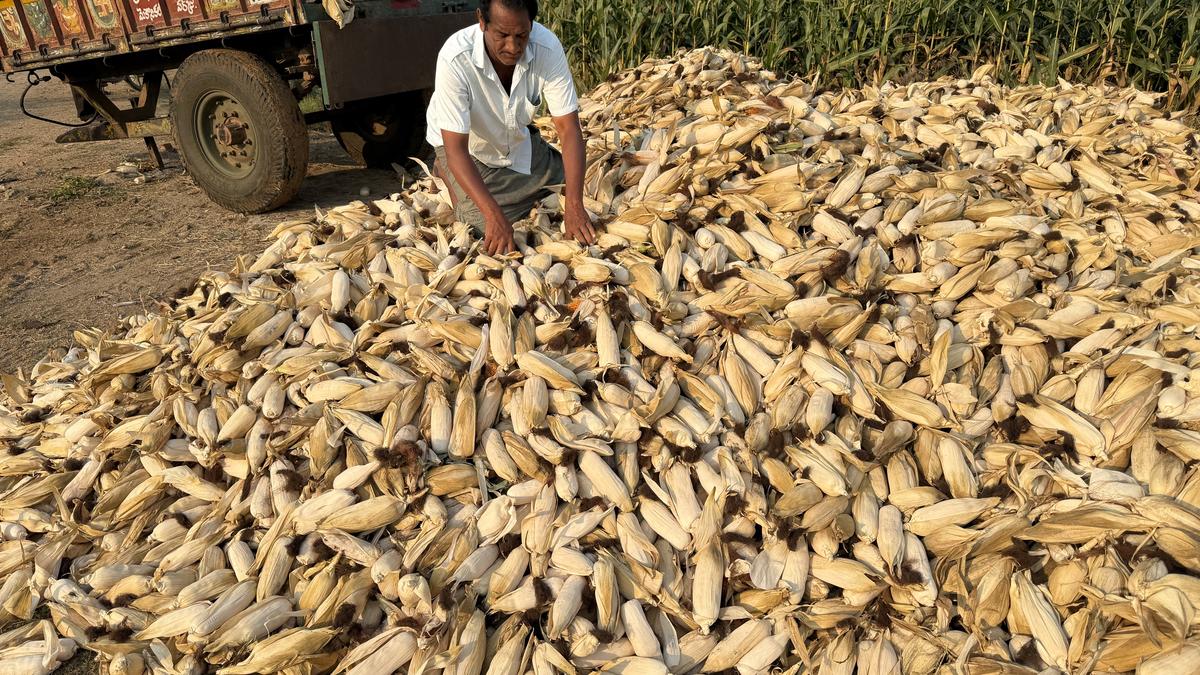A farmer works at a maize field in a village bordering Andhra Pradesh and Telangana, April 20, 2025.
| Photo Credit: G.N. Rao/The Hindu
For every 1º C rise in average temperature worldwide, the per person availability of calories will fall 4% of what’s recommended by 2100. Most major staple crops, including rice, wheat, sorghum, maize, and soybean, will see diminished yields by 2050 as well as 2100. Wheat yield in northern India could be severely affected whereas rice yield in India less so.
These findings are part of a modelling study assessing the impact of rising temperatures on global food production. While such studies are a dime a dozen, this specific study, appearing in Nature, is unique in that it accounts for producer adaptation.
This means being able to fit into a mathematical model how farmers and those connected with agriculture around the world implement measures to adapt to rising temperature, such as by choosing heat-resistant varieties, altering the timing of sowing, and tweaking the times the crops are watered. Accounting for such practices, the authors say, offers a more “realistic” picture of the impact of warming on crop yield.
This mode of analysis, the authors claim, is an improvement over the bulk of existing, comparable econometric analysis. In such studies, projections of productivity are based on outputs from “experimental farms” where conditions are tightly controlled and the researchers impose “adaptation rules”. Such studies have usually projected productivity gains by 2100 of 1.3% for maize, 9.9% for wheat, 15.3% for soybean, and 23.3% for rice.

For their analysis, the researchers relied on what they say was one of the “largest datasets” of subnational crop production available containing 13,500 political units, covering 12,658 subnational administrative units from 54 countries for six staple crops spanning diverse local climates and socioeconomic contexts.
Warming can affect yield by exposing plants to adverse temperature or by altering precipitation, which then affects the optimal moisture available for rice and wheat to properly flower.
Assuming agriculturists globally responded optimally to the changing climate with the appropriate interventions, 23% of global losses could be alleviated in 2050 and 34% at the end of the century but “substantial residual losses” would remain for all staples except rice, the authors note. While similar analyses project the greatest damages to the global poor, the new study suggests global impacts are dominated by losses to “modern-day breadbaskets with favourable climates and limited present adaptation,” although losses in low-income regions were also “substantial.”
Thus, innovation, cropland expansion or further adaptation may be required to ensure food security, they note.
Wheat losses are notably consistent across the main wheat-growing regions, with high-emissions yield losses of -15% to -25% in Eastern Europe, Western Europe, Africa and South America and -30% to -40% in China, Russia, the US, and Canada. There are notable exceptions to these global patterns: “wheat-growing regions of Western China exhibit both gains and losses, whereas wheat-growing regions of Northern India exhibited some of the most severe projected losses across the globe,” the study found.
High-emissions rice yield impacts were “mixed” in India and Southeast Asia, which lead global rice production, with small gains and losses throughout these regions. This regional result was broadly consistent with the work of similar studies. In the remaining rice-growing regions, central estimates are generally negative, with magnitudes in Sub-Saharan Africa, Europe and Central Asia exceeding -50%, the study notes.
Published – June 21, 2025 10:25 am IST
